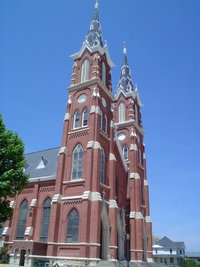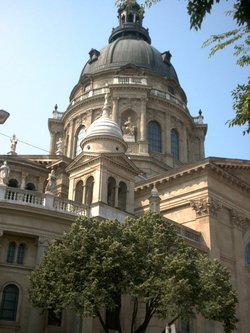Basilica
|
|

The Latin word basilica (derived from Greek basiliké stoà, royal stoa), was originally used to describe a Roman public building (as in Greece, mainly a tribunal), usually located at the centre of a Roman town (forum). In Hellenistic cities, public basilicas appeared in the 2nd century BCE.
After the Roman Empire became officially Christian, the term came by extension to refer to a large, and important church that has been given special ceremonial rights by the Pope, and thus the word retains two senses today, in an architectural context and in an ecclesiastical one.
| Contents |
|
1.1 Basilicas in the Roman Forum |
The basilica in architecture
In architecture the Roman basilica was a large roofed hall erected for transacting business and disposing of legal matters. Such buildings usually contained interior colonnades that divided the space, giving aisles or arcaded spaces at one or both sides, with an apse at one end (or less often at each end), where the magistrates sat, often on a slightly raised dais. The central aisle tended to be wide and was higher than the flanking aisles, so that light could penetrate through the clerestory windows.
The oldest known basilica, the Basilica Porcia, was built in Rome in 184 BCE by Marcus Porcius Cato (Cato the Elder). Other early examples include the one at Pompeii (late 2nd century BCE). Probably the most splendid Roman basilica is the one constructed for traditional purposes during the reign of the pagan emperor Maxentius and finished by Constantine after 313. As early as the time of Augustus, a public basilica for transacting business had been part of any settlement that considered itself a city, used like the late medieval covered markethouses of northern Europe (where the meeting room, for lack of urban space, was set above the arcades.
Basilicas in the Roman Forum
- Porcian Basilica, built by Cato the Elder during the time he was censor
- Aemilian Basilica, built by the censor Aemilius Lepidus in 179 BC
- Julian Basilica, completed by Augustus
- Basilica Opimia, built by Opimius, consul in 169 BC
- Basilica Sempronia, built by the censor Marcus Sempronius Graccus in 169 BC
Palace basilicas
In the early Imperial period, a basilica for large audiences also became a feature in the palaces. In the 3rd century AD, the governing elite appeared less easily in the forums. "They now tended to dominate their cities from opulent palaces and country villas, set a little apart from traditional centers of public life. Rather than retreats from public life, however, these residences were the forum made private." (Peter Brown, in Paul Veyne, 1987). Seated in the tribune of his basilica the great man would meet his dependent clientes early every morning.
A private basilica excavated at Bulla Regia (Tunisia), in the "House of the Hunt," dates from the first half of the 4th century. Its reception or audience hall is a long rectangular nave-like space, flanked by dependent rooms that mostly also open into one another, ending in a circular apse, with matching transept spaces. The "crossing" of the two axes was emphasized with clustered columns.
Christianising the basilica
In the 4th century, Christians were prepared to build larger and more handsome edifices for worship than the furtive meeting places they had been using. Architectural formulas for temples were unsuitable, not simply for their pagan associations, but because pagan cult and sacrifices occurred outdoors under the open sky in the sight of the gods, with the temple, housing the cult figures and the treasury, as a backdrop. The usable model at hand, when Constantine wanted to memorialize his imperial piety, was the familiar conventional architecture of the basilicas [1] (http://www.cartage.org.lb/en/themes/Arts/Architec/MiddleAgesArchitectural/EarlyChristianByzantine/BasilicaPlanChurches/BasilicaPlanChurches.htm). These had a center nave with one aisle at each side and an apse at one end: on this raised platform sat the bishop and priests. Constantine built a basilica of this type in his palace complex at Triers, later very easily adopted for use as a church. It is a long rectangle two stories high, with ranks of arch-headed windows one above the other, without aisles (no mercantile exchange in this imperial basilica) and at the far end, beyond a huge arch, the apse in which Constantine held state. Exchange the throne for an altar, as was done at Triers, and you had a church. Basilicas of this type were built not only in Western Europe but in Greece, Syria, Egypt, and Palestine. Good early examples of the architectural basilica are the Church of the Nativity at Bethlehem (6th century), the church of St Elias at Thessalonica (5th century), and the two great basilicas at Ravenna.
The first basilicas with transepts were built under the orders of Emperor Constantine, both in Rome and his "New Rome," Constantinople:
- "Around 380, Gregory Nazianzen, describing the Constantinian Church of the Holy Apostles at Constantinople, was the first to point out its resemblance to a cross. Because the cult of the cross was spreading at about the same time, this comparison met with stunning successs." ((Yvon Thébert, in Veyne, 1987)
Thus a Christian symbolic theme was applied quite naturally to form borrowed from civil semi-public precedents. In the later 4th century other Christian basilicas were built in Rome: Santa Sabina, St. John Lateran and St. Paul's-outside-the-Walls (4th centuty), and later San Clemente (6th century).
A Christian basilica of the 4th or 5th century stood behind its entirely enclosed forecourt ringed with a colonnade or arcade, like the stoa or peristyle that was its ancestor or like the cloister that was its descendant. This forecourt was entered from outside through a range of buildings along the public street. This was the architectural groundplan of St Peter's Basilica in Rome, until first the forecourt, then all of it was swept away in the 15th century to make way for a great modern church on a new plan.
In most basilicas the central nave is taller than the aisles, forming a row of windows called a clerestory. Some basilicas in the Near East, particularly those of Georgia and Armenia, have a central nave only slightly higher than the two aisles and a single pitched roof covering all three. The result is a much darker interior. This plan is known as the "oriental basilica."
Gradually in the early Middle Ages there emerged the massive Romanesque churches, which still retained the fundamental plan of the basilica.
Architecture: external reference
- Architecture of the basilica (http://employees.oneonta.edu/farberas/arth/arth212/early_christian_basilica.html), well illustrated.
- Basilica Porcia (http://sights.seindal.dk/sight/1193_Basilica_Porcia.html)
Reference
Paul Veyne, ed. A History of Private Life I: From Pagan Rome to Byzantium, 1987
The ecclesiastic basilica
The Early Christian purpose-built basilica was the basilica of the bishop, on the model of the semi-public basilicas of the secular power elite, and its growth in size and importance signalled the gradual transfer of civic power into episcopal hands, under way in the 5th century. Basilicas in this sense are divided into two classes, the greater or patriarchal basilicas, and the lesser basilicas.
Major Basilicas
To the former class belong primarily those five great churches of Rome, which among other distinctions have a special "holy door" and to which a visit is always prescribed as one of the conditions for gaining the Roman Jubilee. They are also called patriarchal basilicas, seemingly as representative of the great ecclesiastical provinces of the world thus symbolically united in the heart of Christendom.
- St. John Lateran is the cathedral of the Patriarch of Rome, the Pope,
- St. Peter's Basilica is assigned to the Patriarch of Constantinople,
- St. Paul outside the Walls to the Patriarch of Alexandria,
- St. Mary Major to the Patriarch of Antioch,
- St. Lawrence outside the Walls to the Patriarch of Jerusalem.
Minor Basilicas
Basilica_st.johns1.jpg
Saint_marys.JPG
There has been a pronounced tendency of late years to add to their number. In 1960, Pope John XXIII even declared Generalisimo Franco's grandiose tomb in the monumental Valley of the Fallen near Madrid a basilica. A list of more recent examples would be a long one.
Oratory
A basilica should not be confused with an oratory which is a semi-private place of worship. All basilicas are public churches. The Oratorians have constructed several oratories, none of which are basilicas.
Ecclesiastical basilicas: external references
- Catholic Encyclopedia: (http://www.newadvent.org/cathen/02325a.htm) Basilica
- Richard Krautheimer, Early Christian and Byzantine Architecture
See also
de:Basilika es:Basílica fr:Basilique lt:Bazilika nl:Basiliek ja:バシリカ no:Basilika pl:Bazylika pt:Basílica


